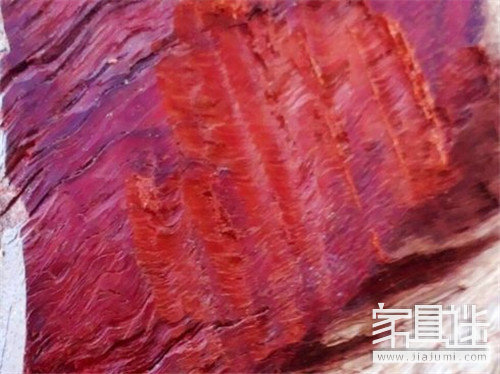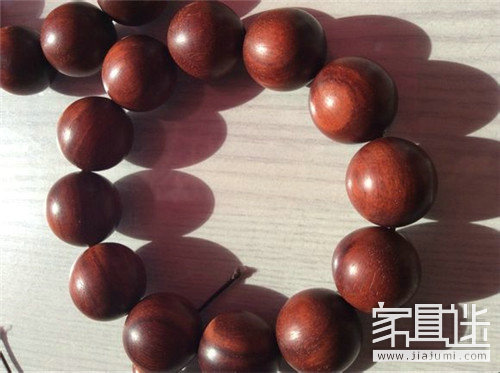Since Zambian rosewood came into the public spotlight, it has sparked a lot of debate. Some people call it "Li Gui," while others think it's just a passing trend in the world of rosewood. However, regardless of the confusion, one fact remains undisputed: Zambian red sandalwood is a genuine and valuable material.

*Figure: Zambian rosewood*
According to the Institute of Wood Science at Nanjing Forestry University, Zambian red sandalwood has an air-dry density of 112g/cm³ and an average hole chord diameter of 145μm. It is the only wood in China, aside from Indian lobular rosewood, that meets the national standard GB/T 18107-2000 for "redwood." This standard requires a dry density over 1.00 g/cm³ and a tube hole diameter no larger than 160μm.
Despite its quality, there is still limited new research on Zambian rosewood. However, those who have worked with it for years know that the material varies significantly. Some pieces are oily, some are less oily than Indian lobular rosewood, and some have a density below 1.0, meaning they don’t sink in water. Therefore, it’s not advisable to judge a piece of wood based solely on its name. In general, the better parts of Zambian rosewood are comparable to Indian lobular rosewood, and overall, it’s superior to big leaf rosewood.
In the industry, some classify Zambian red sandalwood into oil and non-oil types, as well as sinking and non-sinking varieties. Others argue whether these distinctions are real or just myths, even suggesting differences between “male†and “female†wood or attributing variations to environmental factors. There is no consensus, and so far, no unified conclusion has been reached. To address this, many developers are now focusing on improving the consistency of materials through stricter screening during cutting and shipping.
**Related reading:** How to identify fake techniques of rosewood furniture
**There is no right or wrong, only people with good and bad intentions**
Before the second half of 2013, Zambian rosewood was often sold as a substitute for Indian lobular rosewood, which severely damaged its reputation. The term “Li Gui†(false rosewood) became synonymous with deception. This misrepresentation caused many to view Zambian rosewood negatively, even developing a sense of rejection.
In reality, the problem isn’t with the wood itself, but with those who misrepresent it. Wood is just wood, and distinguishing it from Indian lobular rosewood isn’t easy. It’s not the fault of Zambian rosewood; it’s the unethical individuals who try to pass it off as something else. These actions create confusion and distrust among consumers.
Of course, there are also manufacturers who have produced and sold furniture under the correct name of Zambian rosewood. However, due to its high price in the early stages—ranging from 50,000 to 100,000 yuan—only a few companies were involved, and the batches were small. As a result, most of the furniture was considered too expensive compared to Siamese rosewood, making it difficult to find in the mahogany market.
After the price of Zambian rosewood dropped from over 30,000 yuan this July, some manufacturers began purchasing in bulk. With a four-month production cycle, it’s expected that a batch of Zambian rosewood furniture will soon hit the market, making it more accessible to consumers.

**Let the red sandalwood culture offer a new choice to the public**
Redwood is more than just a type of wood—it represents history, culture, and craftsmanship. The legacy of Indian lobular rosewood is unmatched, and no other wood can replace it. Anyone familiar with redwood would agree with that.
When it comes to red sandalwood, the national standard for mahogany must be mentioned. Among the 33 types of wood listed in the standard, eight are named as red sandalwood. But only Indian lobular rosewood truly meets the criteria of a “true red sandalwoodâ€â€”with a density over 1.00 g/cm³ and a tube hole diameter not exceeding 160μm.
This year, the price of Zambian rosewood has seen a significant correction in line with the broader redwood market. While some merchants are unhappy, this adjustment is ultimately positive in the long run. It allows more manufacturers and consumers to engage with and understand the wood, creating opportunities for it to shine.
Zambian rosewood is an emerging wood that meets the standards of rosewood. Although it lacks the historical prestige of Indian lobular rosewood, it offers a more affordable option for more people to own a set of rosewood furniture. This accessibility helps spread the culture of “Purple Qidong,†which should be its greatest value.
Bioplastic Forks,Disposable Bioplastic Forks,Biodegradable Forks,Cutlery Spoon Forks
Anhui Jianfeng Environmental Protection Technology Co., Ltd , https://www.ahbiocutleries.com